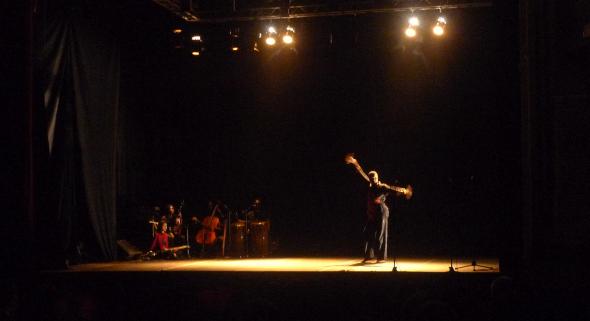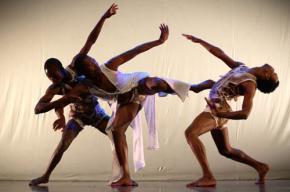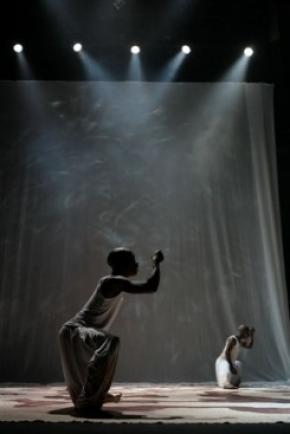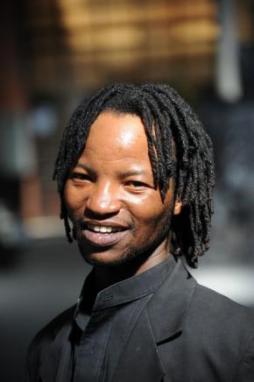The sincretism of Gregory Maqoma
Gregory Maqoma, South-African dancer and choreographer, uses his origins to build his identity as an artist. The performer came to Luanda to present ‘Beautiful Me’, a show in which he is the only participant, and that reflects some of his concerns about south-african society and the political power as a whole, around the world.
 'Beautiful me', photo by Malocha
'Beautiful me', photo by Malocha
In a monologue that goes through-out the entire play, Gregory Macoma presents his thoughts, expresses his opinions and shares his life experiences. “They expect me, constantly, to restrain my work to the stereotyped perception of the western world and the african traditionalism”, says Maqoma. Beautiful Me destroys these stereotypes and offers an alternate vision of a unique artist that possesses his own culture. “I believe that people with a different background can transcend their cultural barriers and develop new cultural dynamics”, he goes. Maqoma was able to step forward towards that goal and invited other choreographers (Akram Khan, Faustin Linyekula and Vincent Mantsoe) to contribute to a “truly universal work”. Their contribution resulted in Beautiful Me and permitted, as he believes, “to narrow the frontiers and consolidate the idea of an African identity as an open subject”.

Black is beautiful
Gregory Maqoma was born in Johannesburg, South Africa. Son of a middle class South-African family, which he considers that “decided to keep away from traditional rituals”. Despite this fact, his curiosity led the young Maqoma to participate in a circumcision ritual. “This initiation showed me that these things really exist but that if you are raised outside this context, the rituals don’t mean a thing”, he says.
While he was still in South-Africa, Gregory soon gains interest and fascination about the artistic world. The one to “blame” for this, is entirely his “grandmother Cecilia Maqoma, that in Port Alfred loved to attend balls”, he tells. Through this family’s influence, the dancer followed his way. Nowadays he feels that he plays a role as an artist “in a very serious way, although I still carry the burden of trying to find a balance between my own identity and what I face every day as a South-African”. The color of the skin is an obvious subject. The apartheid regime, under which he lived, was a catalyst of new artistic ideas. For example, in the play that he now brings to Angola, Gregory Maqoma talks about his colors: red, black and white. The word “black” is used in this choreography without any guilt related to it. As Maqoma says “black was never a color of death, horror and terror. Was never a color of disadvantage or of distance. Black I am. It means beauty, to cherish, to caress, to love…”
The past never dies
In the play ‘Beautiful Me’, that went on stage at the Cine-Teatro Nacional in Luanda, the artist dialogues with the African history. In one of the scenes, Maqoma calls for the names of fallen African leaders and buries them to create a new history. The thoughts come tumbling in, the voices are running wild and against each other. If, for a moment, Maqoma tries to forget the South-African president PW Botha, the next minute he’s having an imaginary conversation with Michael Jackson, in which he recalls his own childhood and youth in South-Africa, living by the rhythm of the songs and the dance steps of the recently diseased King of Pop.
The play is hard to read. The dancer talks about identity and tries to tell the audience that “colonialism spread people away from their culture, making it smaller”, he explains. Performative art critics have written that “artists like Maqoma, and other pioneers before him, are a part of process of rediscovery, reinvention and re-presentation of African history”. About that, the dancer says that “doing it is hard and complex because the past may be full of shame, guilt and anger, but it is also full of pleasure, pride and wisdom. We want to bury the negative side in the attempt to create something new and better, but the past never dies”.
rising career
Gregory Vuyani Maqoma started creating choreographies in 1987 while he was in a youth association in Soweto. At that time he had already approached issues which afected South African society. His formal training in the dance field started in 1990 at the Moving Into Dance Mophatong, a school and dance company from Johannesburg. He remembers that institution as “the first mixed, non-racial school for dancers”. A year later he was accepted in that company as a dancer. In 1992 he finished an one year dance teacher training course in that same school. In 1994 he created his first work for that company, for which he was awarded with a FNB Vita Pick of the Fringe Award. A year later he received another one, the FNB Vita Pick of the Stepping Stones Award. In 1997 he went to Vienna, in Austria, with a scholarship to study at the Dance Web. In 1998 Maqoma continued being recognized and he received a scholarship as young creator which he used to make Layers of Time, dedicated to the Moving Into Dance Mophatong’s 20th anniversary.
brussels on his way
In 1999 his career suffered a boost. He was nominated for the Best Choreographer of the Year category with the piece of work Layers of Time and he received a scholarship to study in PARTS (Performing Arts Research and Training Studios) in Brussels, Belgium. The times he spent there are very productive. Maqoma founded the Vuyani Dance Theatre Project and created Rhythm 1.2.3, which was first presented in the Its Festival, in Amesterdam, and for which he was nominated Vita Choreographer of the Year 2000. In 2003 Maqoma was nominated Coreographer of The Year by the newspaper This Day and he got the second place in art’s category of Star Top Hundred People 2003. In 2005 he started the creation of the Beautiful triologie, which he brought to Angola in July.
dance teacher
Besides working as a choreographer for his dance company, Maqoma teaches and choreographs for other companies such as the Pretoria Technicon, Moving Into Dance Mophatong, The Dance Factory, Jazzart Dance Company, Siwela Sonke, in South Africa, International Theatre School, in Amesterdam, Adzido Pan African Dance Ensemble, in London and Bennington College, in the United States. He also gives international workshops on African dance and culture and choreography. To his students he gives an advice “feel the vibration of your own movement”. The same way he does.
awarded dancer
Gregory Maqoma is what we can call an “awards collector”. In 2001 he received the FNB Vita Dance Umbrella Award with his work Rythm Blues. In the same year was selected to create for the Dunhill Symphony of Fire in Nigeria a collage of all his works since 1996, which he called Revolution.
On stage Gregory Maqoma’s style is a true blend of traditional and contemporary. What we can define as “Afrofusion” reflects a major respect for African beliefs and values and, at the same time, a Western contemporary dance form. In Beautiful Me, a solo piece, Maqoma combines the ancestral stomping with modern dance and some movements which remind Indian dance while the sitar music is being played. This dynamic movement style performed by Maqoma has a very important place amongst South Africa’s diverse dance aesthetics nowadays.
Article previously published in Vida magazine, newspaper O PAÍS (Angola 2009)
2st photo from Mail & Guardian